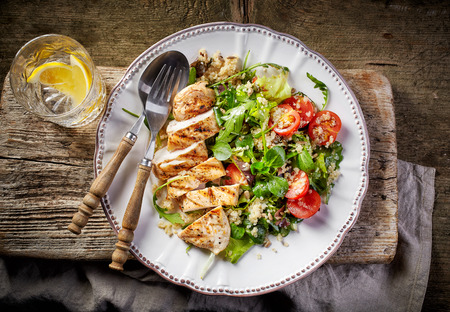A balanced diet is difficult to achieve in this fast-food environment. Healthy eating requires planning.
A meal plan is a great idea. But, where do you start? Here are a few keys to creating the most workable plan for a balanced diet.
Don’t just focus on eating fewer calories. What foods you eat is just as important as how much you eat. That’s because the food choices you make are instrumental in helping to achieve a healthy balanced diet.
A Balanced Diet Weight Loss Meal Plan
- Includes plenty of protein and fiber. Protein and fiber-rich foods help keep you fuller for longer, reducing cravings and helping you feel satisfied with smaller portions.
- Limits processed foods and added sugar. Rich in calories yet low in nutrients, these foods fail to stimulate fullness centers in your brain and make it difficult to lose weight or meet your nutrient needs.
- Includes a variety of fruits and vegetables. Both are rich in water and fiber, contributing to feelings of fullness. These nutrient-rich foods also make it easier to meet your daily nutrient requirements.
Building Nutrient-Dense Meals
To incorporate these tips into your weight loss meal plan:
- Start by filling one-third to one-half of your plate with non-starchy vegetables. These are low in calories and provide water, fiber, and many of the vitamins and minerals you need.
- Then, fill one-quarter to one-third of your plate with protein-rich foods, such as meat, fish, tofu, seitan, or legumes, and the remainder with whole grains, fruit, or starchy vegetables. These add protein, vitamins, minerals, and more fiber.
- You can boost the flavor of your meal with a dash of healthy fats from foods like avocados, olives, nuts, and seeds.
- Some people may benefit from having a snack to tide their hunger over between meals. Protein- and fiber-rich snacks seem the most effective for weight loss.
- Good examples include apple slices with peanut butter, vegetables and hummus, roasted chickpeas, or Greek yogurt with fruit and nuts.
Pick a Meal Planning Method That Fits Your Routine
- There are various ways to meal plan, so be sure to pick the method that best fits your routine.
- You may decide to batch cook all of your meals over the weekend, so you can easily grab individual portions throughout the week. Alternatively, you may prefer to cook daily, in which case, opting to prep all of your ingredients ahead of time might work best for you.
- If you don’t like following recipes or prefer a little more flexibility, you may opt for a method that requires you to fill your refrigerator and pantry with specific portions of foods each week while allowing you to improvise when putting them together for meals.
- Batch-shopping for groceries is another great strategy that helps save time while keeping your refrigerator and pantry filled with nutrient-dense foods.
- Consider trying an app. Apps can be a helpful tool in your meal planning arsenal.
- Pick enough recipes to ensure that you have enough variety without requiring you to spend all of your free time in the kitchen.
- When selecting how many meals to make, look at your calendar to determine the number of times you’re likely to eat out — whether for a date, client dinner, or brunch with friends.
- Divide the remaining number of breakfasts, lunches, and dinners by the number of meals that you can realistically cook or prepare for that week. This helps you determine the portions of each meal you’ll need to prep.
- Then, simply sift through your cookbooks or online food blogs to pick your recipes.
Consider Healthy Snacks
Allowing yourself to get overly hungry between meals may push you to overeat at your next meal, making it more difficult to reach your weight loss goals. Snacks can help lower hunger, promote feelings of fullness, and reduce the overall number of calories you eat per day.
Protein- and fiber-rich combinations, such as nuts, roasted chickpeas, or veggies and hummus, appear best suited to promote weight loss.
Speed Up Your Meal Prep Time
Meal prepping for a balanced diet doesn’t have to mean long hours in the kitchen. Here are a few ways to speed up your meal prep time.
- Stick to a routine.
- Grocery shop with a list.
- When batch cooking, select recipes that use different appliances.
- Schedule your cook times.
- Choose recipes that can be prepared in 15–20 minutes from start to finish.
Click here to read full article on achieving a balanced diet by meal planning.






